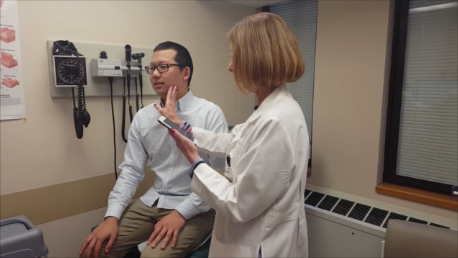Home » Mobile Cloud Computing » Students develop mobile application aimed at improving malnutrition screening at VUMC
Students develop mobile application aimed at improving malnutrition screening at VUMC
Posted by anderc8 on Monday, December 19, 2016 in Mobile Cloud Computing, News.

Dr. Silver demonstrates on Sirui how the application might be used in a physical exam. This was a pivotal moment in the design process and critical for creating the final workflow of the app.
Blog post written by Sirui Ma, a Vanderbilt student enrolled in UNIV 3278 (Tackling Big Questions with Mobile Cloud Computing)
This semester, as part of the inaugural class of UNIV 3278 Tackling Big Questions with Mobile Computing, I have been leading a team of software engineers to develop a mobile application to improve malnutrition screening at Vanderbilt University Medical Center. The course began with lectures on leading software development projects, a completely foreign topic for me and my fellow UNIV students. We learned about various ways of communicating effectively with software engineers, managing the expectations of clients, and leading a development process centered on creating a product with demonstrable progress. These lessons would prove critical as we moved into the actual development phase. These initial lectures were followed by a series of presentations from mentors from all different areas of the university. The beauty of these presentations is that they don’t lay out projects for you; rather, mentors present particular problem in their field and the prerogative lies on us to conceptualize and create novel solutions.
Based on my interest in medicine, I knew I was going to work with one of the mentors from the medical center, and they posed various interesting problems from adolescent diabetes management to pediatric asthma monitoring. I was fascinated by a presentation on the pervasiveness of malnutrition in hospitals and realized that I could help develop a mobile application that could tackle this serious problem. I decided to propose a project structured around this issue, and I was paired with Dr. Heidi Silver, a professor and researcher at the Vanderbilt Center for Human Nutrition.
After my initial proposal, I was assigned a team of three computer science majors. We got to work quickly on fine-tuning the specifications defining application functionality, working closely with Dr. Silver and her team on deciding what features were to be included. The project was revised several times as we moved towards a refined plan for the mobile application. Once development began, I structured our process around producing a weekly demo of progress to Dr. Silver and her team. The feedback we received was critical for shaping future iterations of the application.
Nutri-Risk, as we came to call the application, is an iOS application that integrates seamlessly with a standard physical examination to guide healthcare providers through screening their patients for symptoms of malnutrition. Providers are given quick access to pertinent diagnostic information, and Nutri-Risk produces a summary of the examination that aids in producing a final diagnosis of malnutrition. Furthermore, user engagement with the application is monitored to assess specific user behavioral patterns, and notifications can be readily deployed to encourage application use.
This final product represents the hard work and dedication of a team with diverse skill-sets (software engineers, project managers, and medical experts) unified by the singular goal of tackling malnutrition. This tremendously unique course offering has effectively created bridges across the School of Engineering, College of Arts and Science, and Vanderbilt University Medical Center, promoting interdisciplinary work in a way I never thought possible. Being able to collaborate actively with students and mentors across campus on challenging projects has taught me the synergistic output possible in combining diverse talents and perspectives, and this course has also effectively prepared me for tackling the challenges that can arise in interdisciplinary collaboration. For someone like me who plans to pursue a career in medicine and mobile health, the experience that UNIV 3278 has provided is simply invaluable.
Nutri-Risk represents an ongoing development process, and I can’t wait to see what another semester of collaborative work can accomplish on this mobile application. Stay tuned!
7 Comments on “Students develop mobile application aimed at improving malnutrition screening at VUMC”
Grace Sregina on March 21st, 2017 at 6:54 am
Thanks for sharing the blog, which indicates that how the mobile app will helpful in medical industry. In 2017, there are many high quality hospitality mobile asps are available at the app store.
Sarathi on March 23rd, 2017 at 6:56 am
Its good to focus that mobile technology plays an vital role in Medical Treatments, Good Job by Sirui and Team, Hope mobile technology helps bring down the healthcare cost in providing better and cost effective solutions, which can be helpful for developing different countries.
Deepak D on April 10th, 2017 at 8:27 am
Thanks for such a nice write -up about mobile technology which plays a key role in medical field. Very good job done by sirui, heidi and their team.
Techila on April 5th, 2018 at 1:54 am
Thank you Sirui Ma for sharing such awesome article. Really Noways mobile apps are being more helpful in every industry which includes healthcare industry also and booming also.
Pagalworld on September 27th, 2018 at 12:14 am
Nice post.Thanks for sharing.
Mobile Application on December 20th, 2018 at 9:39 am
great work by the students
Mobile App Development on February 14th, 2019 at 6:30 am
One of the great pieces of information I have come across in past few days. Mobile apps have huge potential to revolutionize the Healthcare industry. With mobile app development technology in Healthcare, we all can expect significant changes in treatment and treating people the right way.
